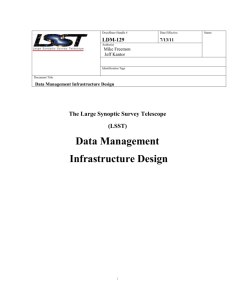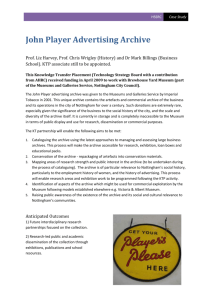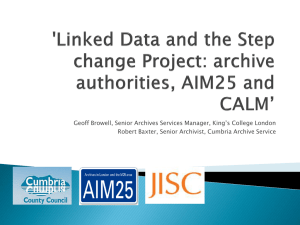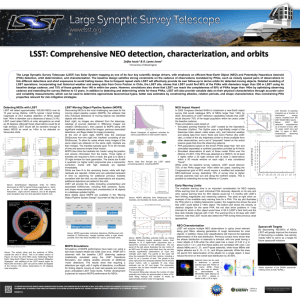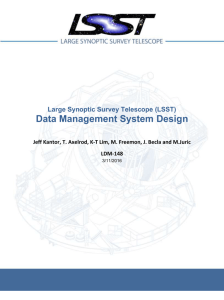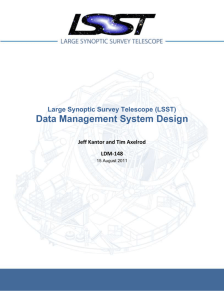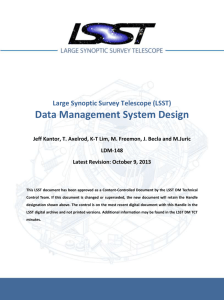Infrastructure Design - DocuShare
advertisement
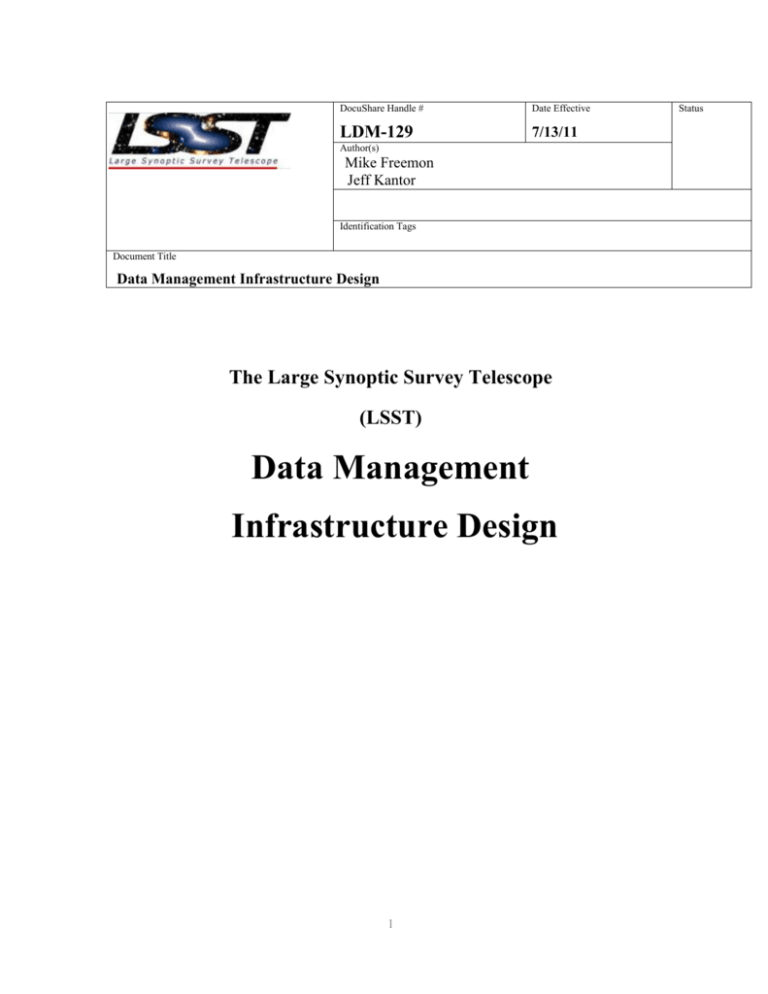
DocuShare Handle # Date Effective LDM-129 7/13/11 Author(s) Mike Freemon Jeff Kantor Id Identification Tags Document Title Data Management Infrastructure Design The Large Synoptic Survey Telescope (LSST) Data Management Infrastructure Design 1 Status Document Control Sheet Version 1.0 Date 7/13/11 Description Initial version as assembled document, previous material was distributed. 2 Owner name Mike Freemon Jeff Kantor Data Management Infrastructure Design Table of Contents 1 Overview ......................................................................................................................... 4 2 Infrastructure Components.............................................................................................. 5 3 Facilities .......................................................................................................................... 8 3.1 National Petascale Computing Facility, Champaign, IL, US ................................... 8 3.2 NOAO Facility, La Serena, Chile ............................................................................ 9 4 Computing..................................................................................................................... 10 5 Storage .......................................................................................................................... 10 6 Mass Storage ................................................................................................................. 11 7 Databases ...................................................................................................................... 12 8 Additional Support Servers ........................................................................................... 12 9 Cluster Interconnect and Local Networking ................................................................. 13 10 Long Haul Network ...................................................................................................... 14 11 Policies .......................................................................................................................... 16 11.1 Replacement Policy ............................................................................................ 16 11.2 Storage Overheads .............................................................................................. 16 11.3 Spares (hardware failures) .................................................................................. 16 11.4 Extra Capacity .................................................................................................... 16 11.5 Contingency ........................................................................................................ 16 12 Disaster Recovery ......................................................................................................... 17 13 CyberSecurity ............................................................................................................... 17 3 1 Overview The Data Management Infrastructure is composed of all computing, storage, and communications hardware and systems software, and all utility systems supporting it, that form the platform of execution and operations for the DM System. All DM System Applications and Middleware are developed, integrated, tested, deployed, and operated on the DM Infrastructure. This document describes the design of the DM Infrastructure at the highest level of discussion. It is the “umbrella” document over many other referenced documents that elaborate on the design in greater detail. The DM System is distributed across four sites in the United States and Chile. Each site hosts one or more physical facilities, in which reside DM Centers. Each Center performs a specific role in the operational system. Figure 1 Data Management Sites, Facilities, and Centers The Base Center is in the Base Facility on the AURA compound in La Serena, Chile. The primary role of the Base Center is: Alert Production processing to meet the 60 second latency requirement Data Access 4 The Archive Center is in the National Petascale Computing Facility at NCSA in Champaign, IL. The primary role of the Archive Site is: Data Release Production processing Data Access Both sites have copies of all the raw and released data for data access and disaster recovery purposes. The Base and Archive Sites host the respective Base and Archive Centers, plus a co-located Data Access Center (DAC). The Headquarters Site final location is not yet determined, but for planning and design purposes is assumed to be in Tucson Arizona. While the Base and Archive Sites provide large-scale data production and data access at supercomputing center scale, the Headquarters is only a management and supervisory control center for the DM System, and as a result is much more modest in terms of infrastructure. 2 Infrastructure Components The Infrastructure is organized into components, which are each composed of hardware and software integrated and deployed as an assembly, to provide computing, communications, and/or storage capabilities required by the DM System. The components are named according to this role. By convention, each infrastructure component is associated with the main center (Archive or Base Center) unless it is part of the co-located DAC. The infrastructure components specific to the Data Access Center are: L3 Community Scratch L3 Community Images L3 Community Compute L3 Community Database Query Access Database Cutout Service 5 Figure 2 Infrastructure Components at Archive and Base Sites 6 Both the Base Center and the Archive Center have essentially the same architecture, differing only by capacity and quantity. There are different external network interfaces depending on the site. Table 1 DM Infrastructure Capacities and Quantities The capacities and quantities are derived from the scientific, system, and operational requirements via a detailed sizing model. The complete sizing model and the process used to arrive at the infrastructure is available in the LSST Project Archive. This design assumes that the DM System will be built using commodity parts that are not bleeding edge, but rather have been readily available on the market for one to two years. This choice is intended to lower the risk of integration problems and the time to build a working, production-level system. This also defines a certain cost class for the computing platform that can be described in terms of technology available today. We then assume that we will be able to purchase a system in 2020 in this same cost class with the same number of dollars (ignoring inflation); however, the performance of that system will be greater than the corresponding system purchased today by some performance evolution curve factor. Note that the current baseline for power, cooling, and floor space assumes air-cooled equipment. If the sizing model or technology trends change and we find that flops per watt is the primary constraint in our system design, we will evaluate water-cooled systems. 7 Finally, note that Base Site equipment is purchased in the U.S., and delivered by the equipment vendors to the Archive Site in Champaign, IL. NCSA installs, configures, and tests the Base Site equipment before shipping to La Serena. When new Data Release data has been generated and validated, the new DRP data is loaded onto the disk storage destined for La Serena. 3 Facilities This section describes the operational characteristics of the facilities in which the DM infrastructure resides. 3.1 National Petascale Computing Facility, Champaign, IL, US The National Petascale Computing Facility (NPCF) is a new data center facility on the campus of the University of Illinos. It was built specifically to house the Blue Waters system, but will also host the LSST Data Management systems. The key characteristics of the facility are: 24MW of power (1/4 of campus electric usage) 5900 tons of CHW cooling F‐3 tornado & Seismic resistant design NPCF is expected to achieve LEED Gold certification, a benchmark for the design, construction, and operation of green buildings. NPCF's forecasted power usage effectiveness (PUE) rating is an impressive 1.1 to 1.2, while a typical data center rating is 1.4. PUE is determined by dividing the amount of power entering a data center by the power used to run the computer infrastructure within it, so efficiency is greater as the quotient decreases toward 1. Three on-site cooling towers will provide water chilled by Mother Nature about 70 percent of the year. Power conversion losses will be reduced by running 480 volt AC power to compute systems. 8 3.2 The facility will operate continually at the high end of the American Society of Heating, Refrigerating and Air-Conditioning Engineers standards, meaning the data center will not be overcooled. Equipment must be able to operate with a 65F inlet water temperature and a 78F inlet air temperature. Provides 1 or 10 gigabit high-performance Ethernet connections as required with up to 300 gigabit external network. There is no UPS in the PCF. LSST will install rack-based UPS systems to keep systems running during brief power outages and to automatically manage controlled shutdowns when extended power outages occur. This ensures that file system buffers are flushed to disk to prevent any data loss. NOAO Facility, La Serena, Chile NOAO is expanded their facility in La Serena, Chili, in order to accommodate the LSST project. Refer to the Base Site design in the Telescope and Site Subsystem for more detail. 9 4 Computing This section defines the design for the computing resources at the Centers. Hardware is purchased in the year before it is needed in order to leverage consistent price/performance improvements. For example, the equipment is purchased in 2020 in order to meet the requirements to produce Data Release 1 in 2021. There is also an equipment “ramp up” period for the two years before Operations (2018 and 2019), since Construction and Commissioning requirements are lower. 5 Storage Image storage will be controller-based storage in a RAID6 8+2 configuration for protection against individual disk failures. GPFS is the parallel file system. GPFS was chosen as the baseline for the parallel filesystem implementation based upon the following considerations: NCSA has and will continue to have deep expertise in GPFS, HPSS, and GHI GPFS, HPSS, and GHI integral to Blue Waters Blue Water is conducting extensive scaling tests with GPFS and any potential problems that emerge at high loads will be solved by the time LSST going into Operations LSST gets special pricing for UIUC-based GPFS installations due to University of Illinois' relationship with IBM. These licensing terms were arranged as a result of the Blue Waters project. o They are quite favorable and even at the highest rates are lower than NCSA can currently get for equivalent Lustre service NCSA provides level 1 support for all UIUC campus licenses under the site licensing agreement. Choice of parallel filesystem implementation is transparent to users of LSST 10 Figure 3. Storage for LSST Image Products. The green shows the mass storage disk cache, a key element for the GPFS-HPSS integration that creates a transparent hierarchical storage environment. 6 Mass Storage The mass storage system will be HPSS. The GPFS-HPSS Interface (GHI) is used to create a hierarchical storage system. All client interaction (meaning both processing and people) is with the single GPFS namespace. The mass storage system is completely transparent to all clients. The mass storage system at the Archive Site will write data to dual tapes, with one going offsite for safe keeping. The Base Site will write a single copy. At Year 5 during Operations, a new tape library system will be purchased to replace the existing library equipment. 11 7 Databases The relational database catalogs are implement with qserv, an approach similar to the mapreduce approach in architecture, but applied to processing sql queries. The database storage is provided via local disk drives within the database servers themselves. See Document11625 for additional information. Figure 4 The Qserv Database Infrastructure 8 Additional Support Servers There are a number of additional support servers in the LSST DM computing environment. They include: User Data Access – login nodes, portals Pipeline Support - Condor, Activemq Event Brokers Inter-Site Data Transfer Network Security Servers (NIDS) Figure 5 Additional Support Servers in the DM Computing Environment 12 9 Cluster Interconnect and Local Networking The local network technologies will be a combination of 10GigE and InfiniBand. 10GigE will be used for the external network interfaces (i.e. external to the DM site), user access servers and services (e.g. web portals, VOEvent servers), mass storage (due to technical limitations), and the Long Haul Network (see the next section). 10GigE is ubiquitous for these uses and is a familiar and known technology. InfiniBand will be used as the cluster interconnect for intra-node communication within the compute cluster, as well as to the database servers. It will also be the storage fabric for the image data. InfiniBand provides the low-latency communication we need at the Base Site for the MPI-based alert generation processing to meet the 60-second latency requirements, as well as for the storage I/O performance we need at the Archive Site for Data Release Production. By using InfiniBand in this way, we can avoid buying, implementing, and supporting the more expensive Fibre Channel for the storage fabric. Although consolidation of networking fabric expected, we do not yet assume this for the baseline design. Figure 6 Interconnect Family Share Over Time 13 10 Long Haul Network Figure 7 The LSST Long Haul Network The communication link between Summit and Base will be 100 Gbps. The network between the Base Site in La Serena, and the Archive Site in Champaign, IL, will support 10 Gbps minimum, 40 Gbps during the night hours, and 80 Gbps burst capability in the event we have a service interruption and need to “catch up”. The key features of the network plan are: Mountain summit – Base is only new fiber, 100 Gbps capacity Inter-site Long-Haul links on existing fibers, protected circuits LSST is leveraging and driving US - Chile long-haul network expansion Capacity growth supports construction and commissioning 1 Gb/s 2011, 3 Gb/s 2018, 10-40-80 Gb/s 2019 Equipment is available today at budgeted cost Additional information can be found in the Network Design Document, LSE-78. 14 Figure 8 The Key Data Flows over the International Network Images crosstalk-corrected at the Summit are sent to the Base Site and fed directly into the memory of Alert Production processing. Those images are processed immediately and the resulting alerts are provided to the VOEvent network in La Serena within 60 seconds of shutter close. Raw image data is transmitted to the Archive Site. Neither the crosstalk-corrected images, nor the products from Alert Production at the Base Site are transferred to the Archive Site. The Archive Site reprocesses raw images. The computing demands for this reprocessing at the Archive Site are far less than at the Base Site since there is no 60-second latency requirement at the Archive Site. As noted earlier in this document, Base Site hardware is purchased at the Archive Site and shipped to the Base Site. Annual Data Release Production Products will be loaded on the new disk hardware purchased at the Archive Site before it is shipped to the Base Site. This forms a type of “sneakernet” to get the Data Release Products to the Base Site. 15 11 Policies A just-in-time approach for purchasing hardware is used to leverage the fact that hardware prices get cheaper over time. This also allows for the use of the latest features of the hardware if valuable to the project. We buy in the fiscal year before the need occurs so that the infrastructure is installed, configured, tested, and ready to go when needed. There is also a ramp up of the initial computing infrastructure during the last two years of Construction. Shown in this section are various polices that we implement for the DM computing infrastructure. 11.1 Replacement Policy Compute Nodes Disk Drives Tape Media Tape Library System 5 Years 3 Years 5 Years Once at Year 5 11.2 Storage Overheads RAID Filesystem 20% 10% 11.3 Spares (hardware failures) Compute Nodes Disk Drives Tape Media 3% of nodes 3% of drives 3% of tapes 11.4 Extra Capacity Tape 10% of TB 11.5 Contingency Compute algorithms 50% of TF 16 12 Disaster Recovery Mass storage is used at both sites to ensure the safe keeping of data products. At the Archive Site, the mass storage system will write two copies of all data to different media. One set of media stays in the tape library for later recall as needed. The second copy is transported off-site. This protects against both media failures (e.g. bad tapes) and loss of the facility itself. The Base Site will write a single copy of data to tape, which remains near-line in the tape library system. Either Site can be the source of data for recovery of the other Site. 13 CyberSecurity We leverage best practices to ensure a secure computing environment. This includes monitoring such as the use of intrusion detection systems, partitioning of resources such as segregating the L3 compute nodes from the core DM processing nodes, and limiting the scope of authorizations to only that which is needed. LSST has an open data policy. The primary data deliverables of LSST Data Management are made available to the public without any proprietary period. As a result, the central considerations are when applying security policies are not about the theft of L1 and L2 data. The main considerations are: • • • • Data Protection Data Integrity Misuse of Facility L3 Community Data Refer to Document 9733 and Document-10201 for additional information. These are LSST system-wide documents, not just DM, as cybersecurity reaches across to all of the LSST subsystems. 17

